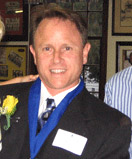Professor G. Ian Gallicano
The ScienceDaily article Type 1 Diabetes: Grow Your Own Transplant? Human Testes Cells Turned Into Insulin-Producing Islet Cells said
“Men with type 1 diabetes may be able to grow their own insulin-producing cells from their testicular tissue, say Georgetown University Medical Center (GUMC) researchers who presented their findings at the American Society of Cell Biology 50th annual meeting in Philadelphia.Their laboratory and animal study is a proof of principle that human spermatogonial stem cells (SSCs) extracted from testicular tissue can morph into insulin-secreting beta islet cells normally found in the pancreas. And the researchers say they accomplished this feat without use of any of the extra genes now employed in most labs to turn adult stem cells into a tissue of choice.
‘No stem cells, adult or embryonic, have been induced to secrete enough insulin yet to cure diabetes in humans, but we know SSCs have the potential to do what we want them to do, and we know how to improve their yield,’ says the study’s lead investigator, G. Ian Gallicano, Ph.D.”
G. Ian Gallicano, Ph.D. is Associate Professor, Department of Cell Biology, Georgetown University Medical Center. He is also Director of the Transgenic Core Facility at GUMC.
Ian focuses on cellular adhesion in capillary formation during early embryogenesis in mammals, and then uses this knowledge to investigate capillary formation in tumors of different sexes (e.g., breast cancer vs. prostate cancer) so as to block tumor vascularization.
Currently, two projects are ongoing in his laboratory. The first project investigates cellular adhesion in capillary formation during early embryogenesis in mammals. He then applies that knowledge to capillary formation in tumors so as to block tumor vascularization. To do so, he uses three distinct biological disciplines, Microscopic, Molecular, and Biochemical analyses, all of which have begun to shed light on the importance of certain components involved with cellular adhesion during capillary formation in the embryo. One specific cell adhesion component he works on is desmoplakin, a major building block of junctions known as complexus adherens junctions in cells that comprise capillaries.
To study desmoplakin in detail he has used embryonic stem cell technology to “knock out” the desmoplakin gene in mice. Embryos that lack desmoplakin die about 6 days after fertilization because they fail to expand their egg cylinders (the main structure that houses the embryo in the uterus). Partial rescue of these embryos using a technique called tetraploid aggregation revealed that capillaries lacking desmoplakin fail to form properly causing embryonic lethality at embryonic Day 10. Numerous other problems (e.g., decreased cellular proliferation) also are found in these early stage embryos lacking desmoplakin and he is currently trying to determine how the loss of desmoplakin causes these problems during development.
The second project in his laboratory investigates a mutant form of desmoplakin (DP) that causes distinct cardiomyopathies (left ventricular dilated forms), which was recently discovered in children (Norgett et al., 2000). This finding begs further investigation using in-vitro cell culture and mice as model systems for understanding, in more detail, the onset of the disease pathology and possible ways to correct it. To date, however, except for his laboratory, few models have been produced with mutations in DP resulting in heart defects.
Ian authored Composition, regulation, and function of the cytoskeleton in mammalian eggs and embryos, and coauthored Desmoplakin Is Required Early in Development for Assembly of Desmosomes and Cytoskeletal Linkage, Rescuing desmoplakin function in extra-embryonic ectoderm reveals the importance of this protein in embryonic heart, neuroepithelium, skin and vasculature, An Unexpected Localization of Basonuclin in the Centrosome, Mitochondria, and Acrosome of Developing Spermatids, and JAK2/STAT3 Directs Cardiomyogenesis Within Murine Embryonic Stem Cells In Vitro.
Ian earned his BS in Biology in 1989, his MS in Developmental Biology in 1991, and his Ph.D. in Developmental Biology in 1994, all from Arizona State University. He completed his Cold Spring Harbor summer course in Molecular Biology in 1995 and completed his post-doctoral fellowship at the University of Chicago in 2000.
